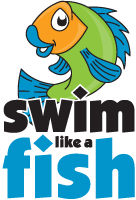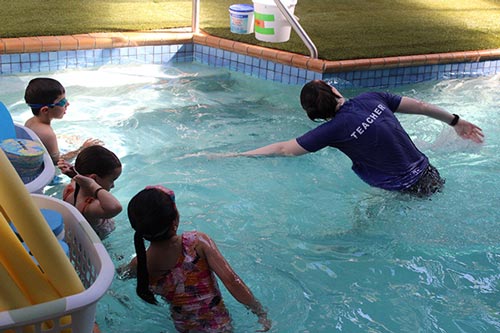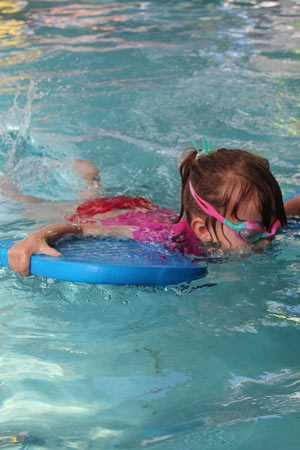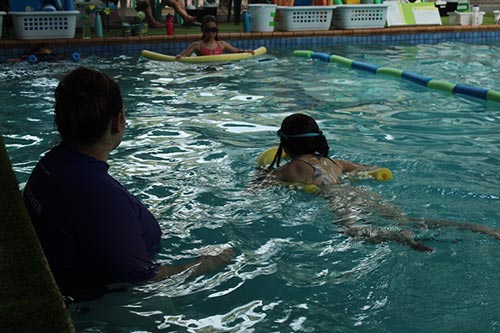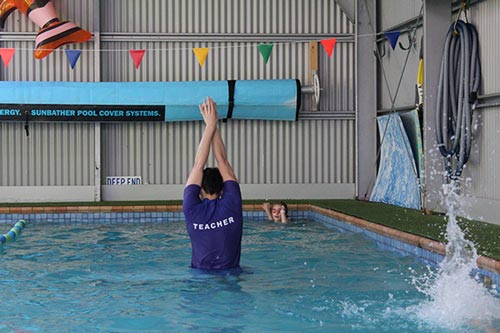Term 4 – 2015 Information Bulletin
Term 4 Mon 5 Oct – Sat 19 Dec
2016
School Holiday Program -TBC
Mon 18 Jan – Fri 22 Jan
Term 1 Wed 27 Jan – Thurs 24 March
Term 2 Mon 11 Apr – Sat 25 June
Term 3 Mon 11 Jul – Sat 17 Sept
Term 4 Mon 3 Oct – Sat 17 Dec
Welcome back to our returning students and welcome to our new families. I hope everyone had a great break over the holidays.
Are you a Water Hero?
Take the online quiz at www.waterhero.com.au
• Be Aware – Don’t let kids out of your sight
• Be Secure – Keep fences and gates locked up tight
• Be Confident – Learn to Swim, and how to get to safety
• Be Prepared – Always have a plan in case of emergency
What are the Benefits of learning to Swim Several Strokes
- When you swim several strokes you use more muscles and your body gets a better workout.
- The risk of a swimming injury is decreased because you don’t always stress the body with the same movements and the musculature is more balanced.
- Your swimming fun is increased because your lessons are more varied when you can choose among strokes.
- The skills that you learn in one stroke can often be transferred to another swim stroke. For example, the balance skills that you learn for the freestyle are also needed in backstroke. Or the body undulation that you need for the butterfly stroke is also an asset while swimming breaststroke.
- Knowing several types of swimming strokes can also be a big advantage for those in triathlons. Obviously, if you know freestyle you will swim faster and tire less than if you only swim breaststroke during the event. Switching to breaststroke in turn can be interesting when you need orient yourself, as you have better visibility than when you are swimming front crawl. And if you know backstroke, you can roll on your back when you are tired and take a few strokes in that position to recover.
(Enjoy swimming Aug 2015-Christophe)Our Team
Please be aware we have some changes to rosters.
| Monday | Emma |
| Monday Evening | Ash, & Mikki |
| Tuesday | Sarah |
| Tuesday Evening | Mikki & Matt |
| Wednesday | Sarah |
| Wednesday Evening | Katie & Ash |
| Thursday | Sarah |
| Thursday Evening | Mikki & Matt |
| Friday | Emma |
| Friday Evening | Lauren & Nick |
| Saturday | Ash, Gen, Lauren & Katie |
We will be running a number of shadowing lessons as part of our teacher’s professional development. You may therefore have two teachers in some lessons as we each watch and learn plus provide feedback to each other.
This is part of our continuing commitment to ensuring we have quality and consistency in our teaching and that all lessons continue to be tailored to meet the needs of your child.
Swim SAFER
A couple of years ago we became part of Swim Australia’s SwimSAFER program. Across all the program, the one central idea is that nothing we do can make children “safe”, but all the things we do in combination can go a long way to reducing a child’s risk around the water.
This includes things children themselves become aware of and do.
National Swim SAFER Week is from
Monday 23 November – Saturday 28 November 2015.
We encourage all children to practice all of the SwimSAFER week’s activities without their goggles on. Although this can be uncomfortable – in reality they would rarely have goggles on in an accidental fall in. During Swim SAFER week we will swim in clothes for each lesson apart from water familiarisation.
Swim SAFER talks about “LAYERS OF PROTECTION”
Four levels of safety measures that must be applied together and at all times in and around any aquatic environment.
Be Aware – Don’t let kids out of your sight
Be Secure – Keep fences and gates locked up tight
Be Confident – Learn to Swim, and how to get to safety
Be Prepared – Always have a plan in case of emergency
BE SECURE
If you have a home pool now is the time to check and make sure that the fences and gates are still SECURE.
Remember just because your child has had swimming lessons and can swim does not mean that they are SAFE in the water, they are SAFER, NEVER SAFE.
What is the history of swimming?
Human beings have been swimming for millennia. According to Wikipedia, Stone Age cave drawings depict individuals swimming and there are written references in the Bible and the Greek poems “The Iliad” and “The Odyssey” dating back 1,500 to 2,000 years. There are even Egyptian clay seals from 4000 BC showing four swimmers doing a version of the crawl, and the most famous swimming drawings were apparently found in the Kebir desert and were estimated to be from around 4000 BC.
According to the Encyclopaedia of Traditional British Rural Sports, literature specifically related to swimming grew in the middle ages. It is believed that the first book devoted to swimming was Colymbetes by Nicolas Wynman written in 1538, and a more widely recognized text, De Arte Nantandi, was published in Latin by Everard Digby in 1587. The encyclopedia also reports that swimming was required of knights and that Romans built bathhouses and pools in the cities they conquered to serve as social clubs and places to exercise.
Organized swimming began in the 1800s and 1900s with the creation of swimming associations and clubs(for example, the Balmain Amateur Swim Club in 1883 – the oldest in Australia) that competed against each other. There are reports from that era of swimming clubs in Australia, England, France, Germany, and the United States. High-profile events also contributed to swimming’s visibility. For instance, Matthew Webb swam the English Channel in 1875.
Competitive swimming continued to grow in popularity during the 1800s and was included in the first modern Olympic Games in Athens in 1896. In 1904, the Olympics in St. Louis included the 50-, 100-, 220-, 440-, 880-yard and one-mile freestyle, the 100-yard backstroke and 440-yard breaststroke, and a 4×50-yard freestyle relay.
By the 20th century, swimming had become mainstream. Indoor pools were beginning to appear, most towns with populations over 20,000 had public outdoor pools, and swimming clubs became increasingly popular for recreation. Women participated for the first time in swimming in the Olympic Games in Stockholm in 1912.
Fee Payments
At the start of term before your child goes into class you will need to pay their fees. Either by direct debit three days prior to your first class or by cash/cheque at the pool on the day of their
first lesson of the term.
If your direct debit is within three days of your first class, please bring a copy of your receipt.
Unfortunately your child will not be able to swim unless payment is made or an arrangement is made with us prior to the start of term.
Please see Kylie to discuss any concerns you may have.
Term 4 2015 – Class Payment Calculation
Tuesday classes are a 10 week term due to Melbourne Cup and Mon, Wed, Thurs, Fri & Sat are an 11 week term.
| Mon, Wed, Thurs, Fri & Sat@ 11 weeks | Tues @ 10 Weeks | |
| 1 child @ $17.50 | $192.50 | $175 |
| 2 Children with 2nd child discount | $363.00 | $330.00 |
| 3 Children with 2nd & 3rd Child discounts | $511.50 | $465.00 |
| Water Familiarisation | $154.00 | $140.00 |
| Swimming Squad | $192.20 | $175.00 |
Sibling Discount
Second and third child discounts apply where you have 2 or more children in classes (not water familiarisation or squad as they are already discounted).
They are calculated at $17.50(1st Child), $15.50 (2nd Child) and $13.50 (3rd Child) per class pro-rata of how many weeks there are in the term, taking into account any public holidays that occur. (It’s $13.50 per class for each child beyond 3)
Water Familiarisation Classes
Tuesday 9.30am – 10.00am &
6.00pm – 6.30pm,
Wednesday 9.30am – 10.00am
Thursday 9.30am – 10.00am
Saturday 9.00am – 9.30am, 9.30am – 10.00am & 11.30am – 12.00noon.
Where the Parents are in the Water with their children. New Water Familiarisation starters commencing after the first week can work out payments pro rata of $14.00 per class. There are no discounts for Water Familiarisation as this is already discounted.
Swimming Squad Classes
Tuesday 5.00pm – 6.00pm
Wednesday 5.30pm – 6.30pm
There are no discounts for squad classes as these are already discounted.
Missed Classes
Missed classes are not to be deducted from the fees unless relating to serious injury/illness and must be discussed with Kylie first. Catch up lessons are available for any missed class for any reason where class sizes permit. As I’m sure you understand we have to pay teachers each
and every week once term classes are set.
Direct Debit details
Account name: Swim Like A Fish
BSB: 633-000
Account no: 140351032.
In working to reduce our carbon footprint, unless requested, receipts will be emailed for cash and cheque payments only from the Wednesday the week after you have paid.
2016 School Holiday
Intensive Swim Program
Mon 18 Jan – Fri 22 Jan 2016
The classes run for one hour each day and cost $110.00 per child.
There is still a maximum of 4 in each class. If you are interested please complete the signup sheet on the table at the desk at the pool or speak to us to book in.
If you have any queries please phone us on
M: 0433 446 403 if you don’t catch us at the pool.
Many thanks, Kylie
